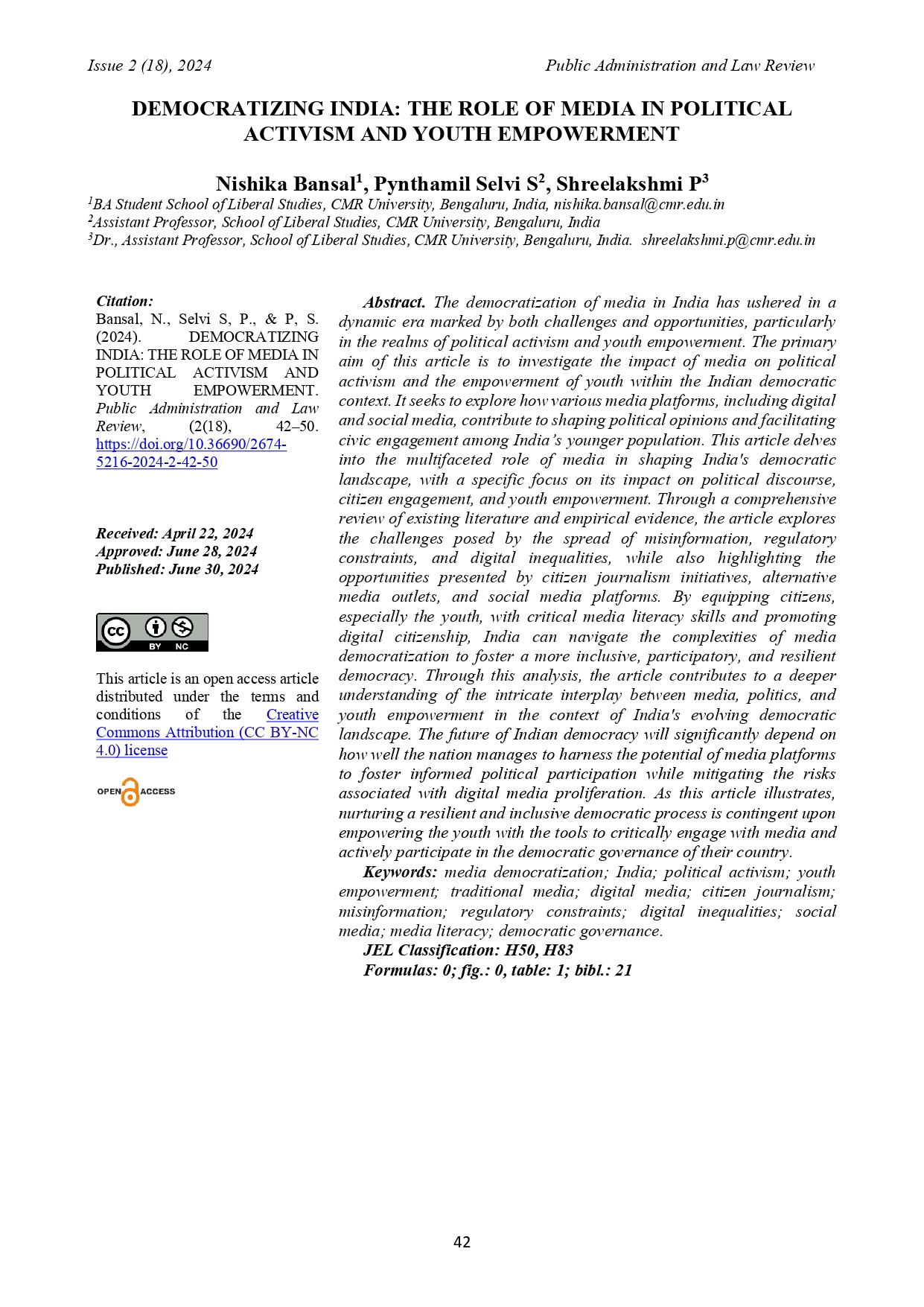DEMOCRATIZING INDIA: THE ROLE OF MEDIA IN POLITICAL ACTIVISM AND YOUTH EMPOWERMENT
DOI:
https://doi.org/10.36690/2674-5216-2024-2-42-50Keywords:
media democratization, India, political activism, youth empowerment, traditional media, digital media, citizen journalism, misinformation, regulatory constraints, digital inequalities, social media, media literacy, democratic governanceAbstract
The democratization of media in India has ushered in a dynamic era marked by both challenges and opportunities, particularly in the realms of political activism and youth empowerment. The primary aim of this article is to investigate the impact of media on political activism and the empowerment of youth within the Indian democratic context. It seeks to explore how various media platforms, including digital and social media, contribute to shaping political opinions and facilitating civic engagement among India’s younger population. This article delves into the multifaceted role of media in shaping India's democratic landscape, with a specific focus on its impact on political discourse, citizen engagement, and youth empowerment. Through a comprehensive review of existing literature and empirical evidence, the article explores the challenges posed by the spread of misinformation, regulatory constraints, and digital inequalities, while also highlighting the opportunities presented by citizen journalism initiatives, alternative media outlets, and social media platforms. By equipping citizens, especially the youth, with critical media literacy skills and promoting digital citizenship, India can navigate the complexities of media democratization to foster a more inclusive, participatory, and resilient democracy. Through this analysis, the article contributes to a deeper understanding of the intricate interplay between media, politics, and youth empowerment in the context of India's evolving democratic landscape. The future of Indian democracy will significantly depend on how well the nation manages to harness the potential of media platforms to foster informed political participation while mitigating the risks associated with digital media proliferation. As this article illustrates, nurturing a resilient and inclusive democratic process is contingent upon empowering the youth with the tools to critically engage with media and actively participate in the democratic governance of their country.
Downloads
References
Allcott, H., & Gentzkow, M. (2017). Social Media and Fake News in the 2016 Election. Journal of Economic Perspectives, 31(2), 211-236.
Buckingham, D. (2019). Media Education and Media Literacy. In The Routledge Handbook of Media Education Research (pp. 31-43). Routledge.
Castells, M. (2012). Networks of outrage and hope: Social movements in the Internet age. Polity.
Chadha, K. (2018). The Indian Media Business. SAGE Publications India.
Chadha, K., & Kavoori, A. P. (2000). Media imperialism revisited: Some findings from the Asian case. Media, Culture & Society, 22(4), 415-432.
Choudhary, V. (2020). Media and Law in India: Debates and Developments. Oxford University Press.
Ghosh, R. (2018). Digital Divide and Social Media: Connectivity Doesn't End Inclusion. Economic & Political Weekly, 53(18), 27-29.
Hobbs, R. (2017). Exploring the Roots of Digital and Media Literacy through Personal Narrative. Journal of Media Literacy Education, 9(1), 1-5.
Livingstone, S. (2004). Media literacy and the challenge of new information and communication technologies. The Communication Review, 7(1), 3-14.
Livingstone, S. (2019). Developing Digital Literacy: Young People's Negotiation of Digital Risks. In The Routledge Companion to Media Education, Copyright, and Fair Use (pp. 201-211). Routledge.
McLeod, J. M., Scheufele, D. A., & Moy, P. (1999). Understanding deliberation: The effects of discussion networks on participation in a public forum. Communication Research, 26(6), 743-774.
Norris, P. (2001). Digital divide: Civic engagement, information poverty, and the Internet worldwide. Cambridge University Press.
Page, D., & Crawley, W. (2001). Satellites over South Asia: Broadcasting, culture and the public interest. Sage.
Raghav, A. (2016). News Media and the Search for a Democratic Space in India. Routledge.
Shah, D. V., McLeod, J. M., & Yoon, S. H. (2007). Communication, context, and community: An exploration of print, broadcast, and Internet influences. Communication Research, 34(4), 318-348.
Shu, K. (2017). Fake News Detection on Social Media: A Data Mining Perspective. ACM Computing Surveys (CSUR), 50(5), 1-36.
The Wire Staff. (2021). Explained: What Are the New IT Rules, and Why Is the Government Going After Twitter Now? The Wire. Retrieved from: https://thewire.in/media/government-social-media-rules-twitter-india
Thussu, D. K. (2007). Media on the move: Global flow and contra-flow. Routledge.
Thussu, D. K. (2019). Mapping BRICS Media. Routledge.
UNESCO. (2013). Media and Information Literacy Curriculum for Teachers. United Nations Educational, Scientific and Cultural Organization.
UNFPA. (2020). State of World Population 2020: Against my will: defying the practices that harm women and girls and undermine equality. United Nations Population Fund.
UNICEF. (2021). The State of the World's Children 2021: On My Mind. United Nations Children's Fund.

Downloads
Published
How to Cite
Issue
Section
License

This work is licensed under a Creative Commons Attribution-NoDerivatives 4.0 International License.





